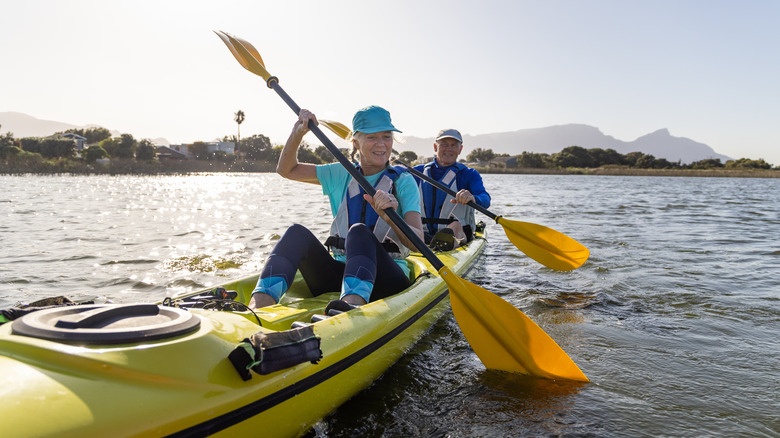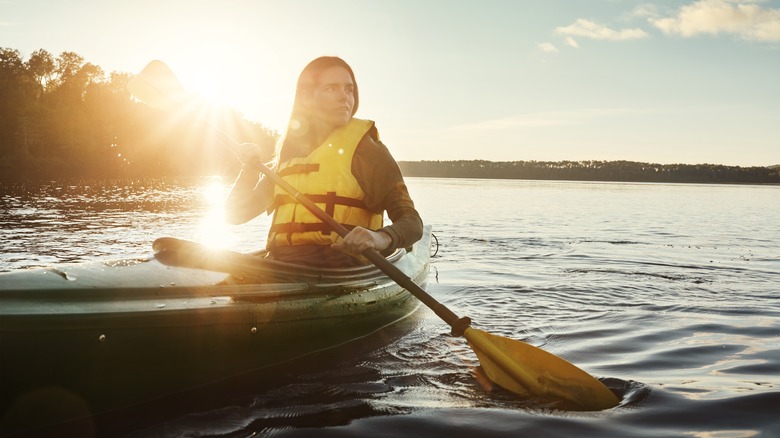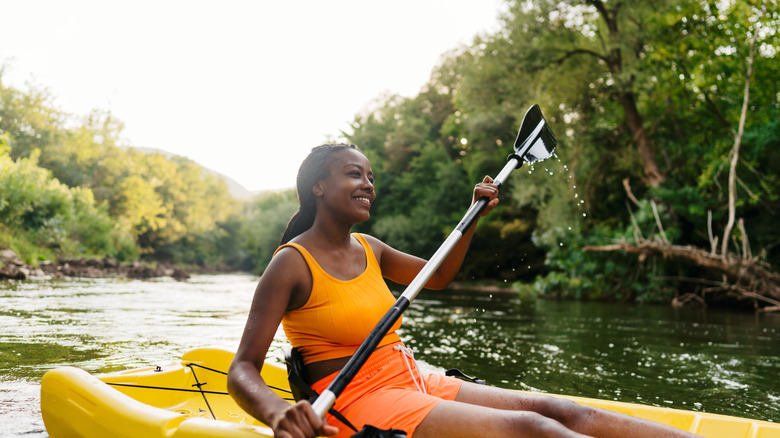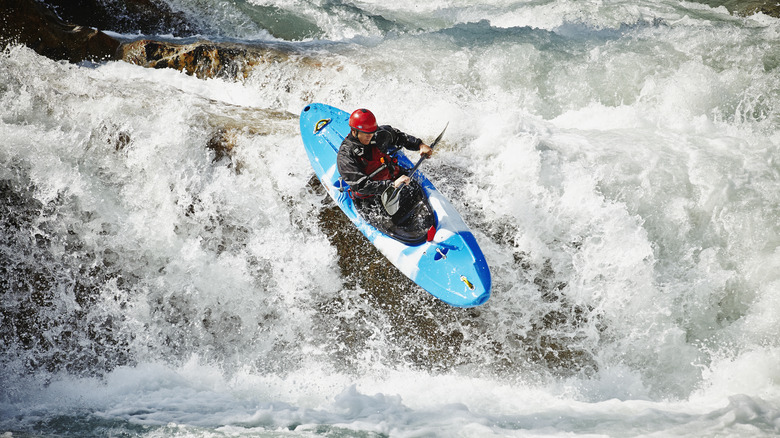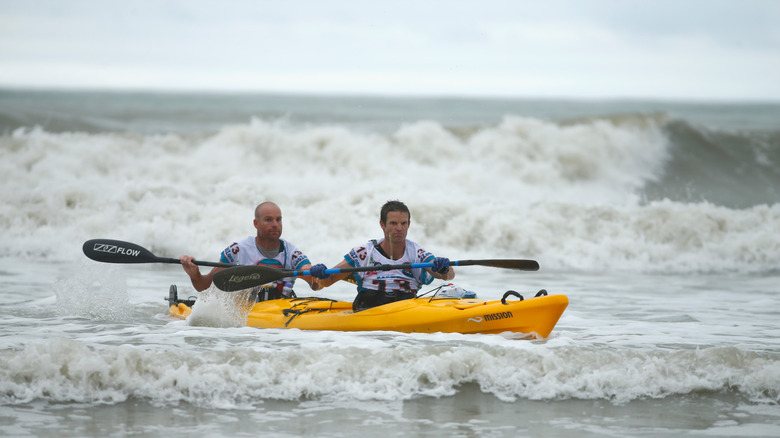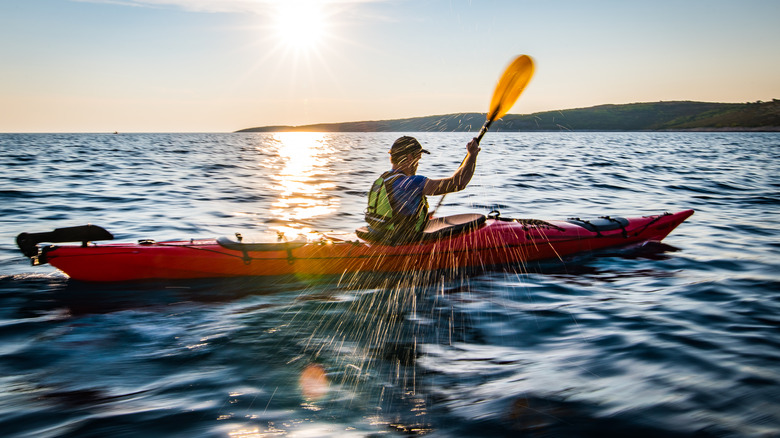How To Safely Kayak In Different Types Of Water
Kayaks have been in use for thousands of years, after being developed by the indigenous Inuit and Aleutian peoples of the Arctic region. Although the use of these versatile crafts wasn't applied to recreational activities until the 1920s, today kayaking is among the most popular watersports in the United States. Just as the native peoples of the Arctic designed the original kayaks to be suitable for use on waters ranging from calm bays to rushing rivers to rough seas, modern-day watersport enthusiasts have adapted them to a variety of regions and types of water.
While the three golden rules of kayaking and the need to be properly equipped and carry necessary safety and lifesaving equipment apply to any paddling situation, there are nuances involved to safely kayaking in different types of water because hidden dangers exist for kayakers on any body of water. Unfortunately, accidents such as capsizing boats and kayaks or drownings do happen, with the U.S. Coast Guard reporting that in 2023 there were 108 drowning deaths for kayakers and canoers.
One of the biggest mistakes kayakers make is underestimating the strength, speed, and danger of water, as even water that appears relatively calm and docile can pose a threat to those who are unprepared or unaware. It is important to use the right kayak and equipment, understand the dynamics of different bodies of water, and develop the necessary skills. So, before you pick your next — or first – kayaking destination, be sure you know how to safely kayak in different types of water.
How to kayak safely on lakes and bays
Calm freshwater lakes and saltwater estuaries and bays are among the safest areas to kayak and are ideal places for beginners to learn the ropes and develop skills. However, there are still potential problems to be aware of even when kayaking relatively calm waters. For one, it is always best to employ the buddy system and never kayak alone. You should also always have a float plan, meaning alert someone who is not on the trip as to the plan and estimated return time. Be sure you have a map or chart of the area and carry a cell phone. A handheld GPS or watch with GPS is a handy addition. These precautions should be considered universal for any type of water.
Additionally, you should always check the weather forecasts and conditions before attempting to paddle any water. On lakes and bays, the biggest factors are typically wind and, on bays, tides. Be sure you know the direction and velocity the wind is blowing when you depart as well as the forecast for your return. It's best on lakes and bays to paddle into the wind — or predicted wind direction — at the onset of your trip so that you can have the wind at your back during your return when you are more likely to be tired. The same goes for the tide when paddling in bays. If the wind and tide are opposing — going in opposite directions of one another — bay conditions can get rough quickly, so it's best to stick to shorelines and protected waters or wait for tides to subside.
Rivers can present challenges for kayakers
In the U.S., there are more than 3 million miles of waterways made up of roughly 250,000 rivers, and many of them offer some sort of kayaking options. However, no two rivers are exactly the same. The one thing all rivers have in common is current. While some are slow-moving, almost as gentle as a lake, others are wild with incredibly strong currents — they all have movement. So, the main thing to be aware of before splashing your kayak in a river is the current throughout the entire stretch of river you intend to paddle. Never try to paddle a stretch of river with currents or hazards that exceed your abilities.
All rivers have a main current and eddies. The main current typically has a steady flow — at least over each stretch of river. Eddies are actually small pockets of calm, protected water that occur behind objects such as rocks, embankments, or logs. Eddies can be used as resting spots to get out of the current. However, you should also be aware that the water where the current and eddy meet will typically be rough and unstable. So, reaching an eddy can be iffy. If you happen to bump sideways against a rock, never lean away from it, as that will lower the kayak towards the current, making capsizing more likely. Instead, lean into the rock and push off with your hands. Another hazard to beware of is a strainer, which is an area such as a fallen tree that allows water through but blocks big objects. Never attempt to paddle through a strainer.
Kayaking rapids require high skill level
Kayakers navigating through runs of rapids result in some of the most iconic kayaking images. However, kayaking rapids is risky and requires skill as well as additional safety equipment. In addition to the safety equipment utilized for any kayaking excursion, when running rapids, it is advisable to wear a helmet and PFD designed to stay face-up should you fall out of your kayak. It is also always important to never attempt a stretch of rapids beyond your ability. If you happen across such a stretch, it is much safer to get out and portage around if at all possible.
When it comes to determining the difficulty of a stretch of rapids, it is important to know rapids are categorized by class, from I to VI. Class I is the easiest. Class III requires at least intermediate skills, while Class IV and above are best left to those with expert skill levels. Within the different classes, there are a variety of features found in different stretches of rapids, such as upstream and downstream V, eddies, whirlpools, and various waves. The basic features to be aware of on any stretch of rapids are the Vs. A downstream V — point facing downstream — forms between two rocks or other objects. The smoothest, safest ride is usually through a downstream V. An upstream V is the opposite — its V points upstream and is formed when water goes over or around an object. Upstream Vs should always be avoided. Additionally, if you see a horizon line, you are likely approaching a steep ledge, drop, or fall. So, it is safest to pull ashore upstream and either scout the area or portage around.
Beachfront kayaking presents unique challenges
Kayaking in surf waters along the beachfront can provide thrills and challenges, but also present some unique dangers. The first of these challenges and dangers starts when launching a kayak from the beach. While some beaches are calm and have very little wave action, often there are rough waves and possibly even dangerous shorebreaks. If waves are breaking close to shore, it is safest to wade out beyond the break, holding the kayak by the front handle or leash. Wait for a break in the waves, then get aboard and begin to paddle out. Most often, this type of kayaking is done with sit-on-top kayaks, as they are easier to enter and exit, more stable, and allow water to drain through as opposed to flooding the craft.
Once you have paddled out beyond the breaking waves, you have the option of paddling parallel to shore if you are just out for a bit of exercise and sightseeing or turning back into the surf zone if you are hoping to catch a wave. Regardless of whether you want to ride a wave or simply return to shore, first find a stretch of sandy beach with few if any people in the water. Then, point the bow of the kayak towards shore and paddle hard. If there are decent-sized waves, try to paddle into the back of one and ride it to shore. If waves are small or nonexistent, you'll need to paddle in the entire way. Be sure to avoid strong riptides, which will push away from shore and make paddling in more difficult.
How to stay safe when open ocean and sea kayaking
Ocean kayaking involves trips in the surf zone and nearshore waters, like those described above, as well as excursions in the open ocean further from shore for fishing, whale watching, sightseeing, or other activities. Sea kayaking involves open ocean ventures that cover more distance over a longer period of time. When you are on the open ocean in a kayak, there are some unique issues you may confront, like possible strong currents and waves. That's why it's imperative to wear a PFD. It is also advisable to have a handheld GPS unit to track your course. Due to the fact that kayaks are difficult to spot in open water, it is also a good idea to have a pennant or flag raised on a flexible poll to make it easier for other boaters to spot you as well as rescuers if you should become lost at sea.
Sea kayaking is also a situation that requires good planning and is best done in a group — or at the very least one other kayak. You should be extra careful to check and double-check not just the weather, but also the direction and speed of offshore currents. Additionally, given cell service can be spotty, if you plan to enter the open ocean in a kayak, a handheld VHF is a good item to add to your supplies. Finally, know your limits and never paddle a distance beyond which you will be unable to paddle back to shore.
